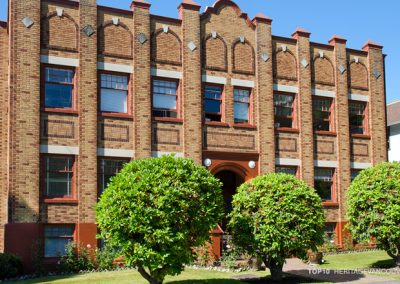Stanley Park has been big news since the catastrophic blow-down of trees during a recent windstorm. But the vulnerability of many of Stanley Park’s cherished heritage landmarks goes unremarked: only two of its heritage sites have legal protection and the Parks Board has not shown any willingness to protect anything else.
As the winds of expediency blow over the park, what will remain of its rich cultural and architectural legacy?
Malkin Bowl, no newcomer to the Top Ten list, is one of the park’s many unlisted heritage sites. Built in 1934 with funds donated by W.H. Malkin, grocery wholesaler, former Mayor and Park Board Commissioner, in memory of his wife Marion, the Bowl, designed by Allen Shakespeare Wooten, Chief Engineer to the Board of Parks Commissioners, is known for its crescent-shaped proscenium arch, is a rustic example of the Moderne style based on the design of the Hollywood Bowl.
Originally designed as a band shell, Theatre Under the Stars (TUTS) has been its long-term occupant. But the beloved landmark has been in serious danger for several years: if Park officials and TUTS management have their way, Malkin Bowl will be demolished and replaced by a high-tech, telescoping, slab-mounted structure. The Park Board considers Malkin Bowl a liability — its isolated location and wooden construction are an open invitation to squatters, vandalism and arson.
The Board’s 2006-08 Capital Plan lists the Bowl for replacement but attaches a ‘zero’ dollar figure, suggesting that TUTS must raise all funds for replacement. It had been attempting to do so until a larger financial crisis emerged: last summer, TUTS cancelled its season due to financial difficulties, raising the possibility that Malkin Bowl could permanently lose its primary tenant. Without a tenant, and no heritage protection, the theatre could be levelled summarily as having no viable use.
Other unprotected sites are vulnerable to inappropriate alteration and loss of original materials: a recent case is Brockton Point Lighthouse. The terraced viewing areas, staircases and walkways around the lighthouse have undergone a major repair and renovation. The terraced area has been altered to accommodate concession facilities and a ‘faux heritage’ retrofit has replaced the historic railings.
Similarly, as part of a ‘restoration’ of the Rose Garden Caretaker’s Cottage, the original siding was removed and replicated with seeming disregard for the value of the historic materials.
Other unprotected sites are: the historic pedestrian bridge at the Lost Lagoon/Coal Harbour entrance to Stanley Park, slated for replacement. The bridge, framed by rusticated granite railings supporting post-top ornamental lamps, forms the familiar arched portal over Stanley Park Drive near the Rowing Club.
Also unprotected is the Art Nouveau-inspired pedestrian bridge over Lost Lagoon Creek and the nearby ‘twig bridge,’ recently damaged by a falling willow. Also worthy of protection are the Beaux Arts stone balustrade that borders the seawall by the Rowing Club and the 1930s Pitch & Putt ‘clubhouse’, with its golfing motifs carved into the fascia boards.
It is clear that more than the wind threatens Vancouver’s beloved Stanley Park. A comprehensive heritage review of Stanley Park is imperative!










